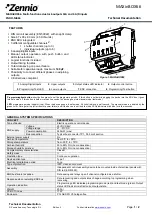
Overview
302
SPNU563A – March 2018
Copyright © 2018, Texas Instruments Incorporated
I/O Multiplexing and Control Module (IOMM)
6.1
Overview
This chapter describes the overall features of the module that control the I/O multiplexing on the device.
The mapping of control registers to multiplexing options is specified in
6.2
Main Features of I/O Multiplexing Module (IOMM)
The IOMM contains memory-mapped registers (MMR) that control device-specific multiplexed functions.
The safety and diagnostic features of the IOMM are:
•
Kicker mechanism to protect the MMRs from accidental writes
•
Error indication for access violations
6.3
Control of Multiplexed Outputs
The signal multiplexing controlled by each memory-mapped control register (PINMMRn) is described in
. Each byte in the PINMMRs control the functionality output on a single terminal. Consider the
following example for the PINMMR9 control register.
Figure 6-1. PINMMR9 Control Register [Address Offset = 134h]
31
27
26
25
24
Reserved
GIOB[4]
Reserved
EMIF_nCS[2]
R/WP-0
R/WP-0
R/WP-0
R/WP-1
23
19
18
17
16
Reserved
N2HET2[7]
RTP_DATA[15]
EMIF nCS[0]
R/WP-0
R/WP-0
R/WP-0
R/WP-1
15
11
10
9
8
Reserved
GIOB[3]
Reserved
EMIF_nCAS
R/WP-0
R/WP-0
R/WP-0
R/WP-1
7
3
2
1
0
Reserved
ECLK2
EMIF_CLK
Reserved
R/WP-0
R/WP-0
R/WP-0
R/WP-1
LEGEND: R/W = Read/Write; R = Read only; WP = Write in privileged mode only; -
n
= value after reset
•
Consider the multiplexing controlled by PINMMR9[23–16]. These bits control the multiplexing between
the EMIF_nCS[0], RTP_DATA[15] and N2HET2[7] on the ball N17 of the 337BGA package for this
device. The default function on the N17 ball is EMIF_nCS[0]. This is dictated by bit 16 of the PINMMR9
register being set.
•
If the application wants to use N17 as an N2HET2[7] signal, then bit 16 of PINMMR9 must be cleared
and bit 18 must be set. Likewise, if RTP_DATA[15] is to be brought out, then bit 16 of PINMMR9 must
be cleared and bit 17 must be set.
•
Each feature of the output function is determined by the function selected to be output on a terminal.
For example, the ball N17 on the 337BGA package is driven by an output buffer with an 8mA drive
strength. This output buffer has the following signals: A (signal to be output) and GZ (output enable).
Each of these signals is an output of a multiplexor that allows the selected function to control all
available features of the output buffer. Some output buffers may have additional options as output
strength, slew rate, and so on. This options are also controlled by the multiplexor output.
•
The PINMMR control registers are used to implement a one-hot encoding scheme for selecting the
multiplexed function.
–
For example, for the N17 ball on the 337BGA package for this device only one out of bit 16, 17 or
bit 18 must be set.
–
If the application clears bits 16, 17 and 18, then the default function, EMIF_nCS[0], will be selected
for output on N17.
–
If the application sets 16, 17 and 18, then the default function will be selected for output on N17.















































